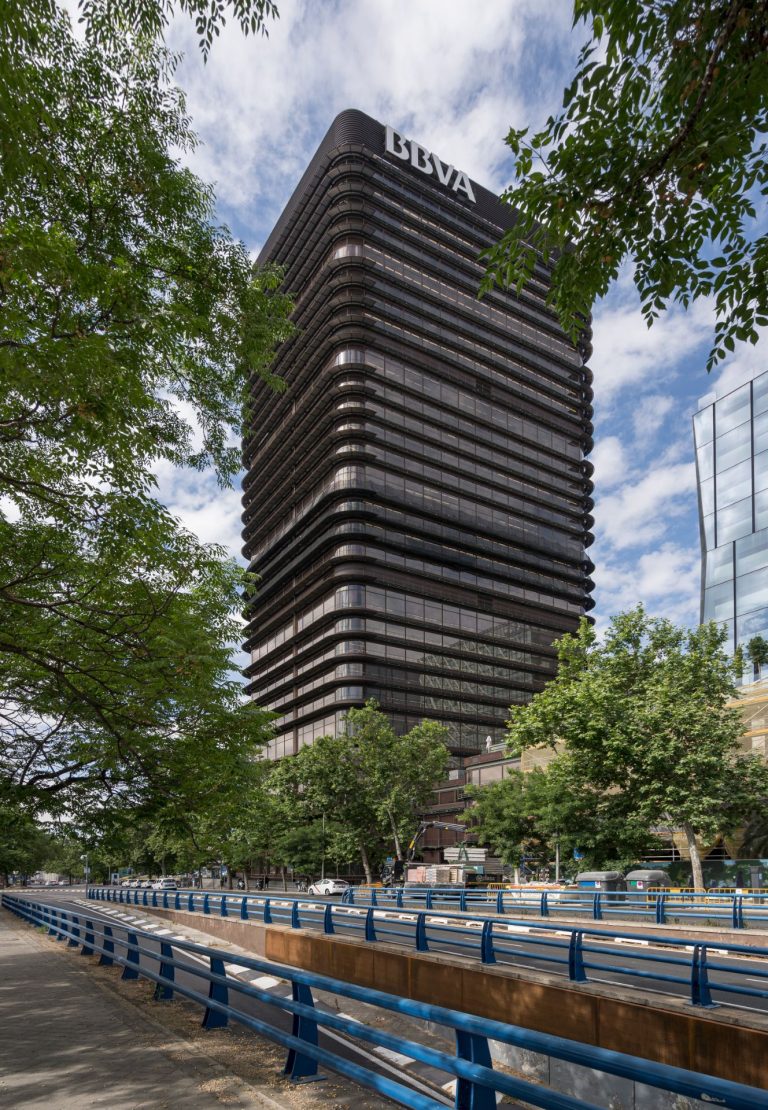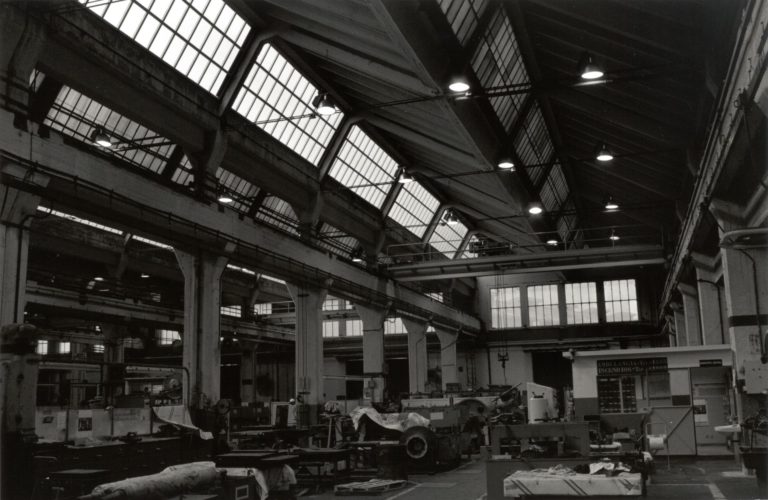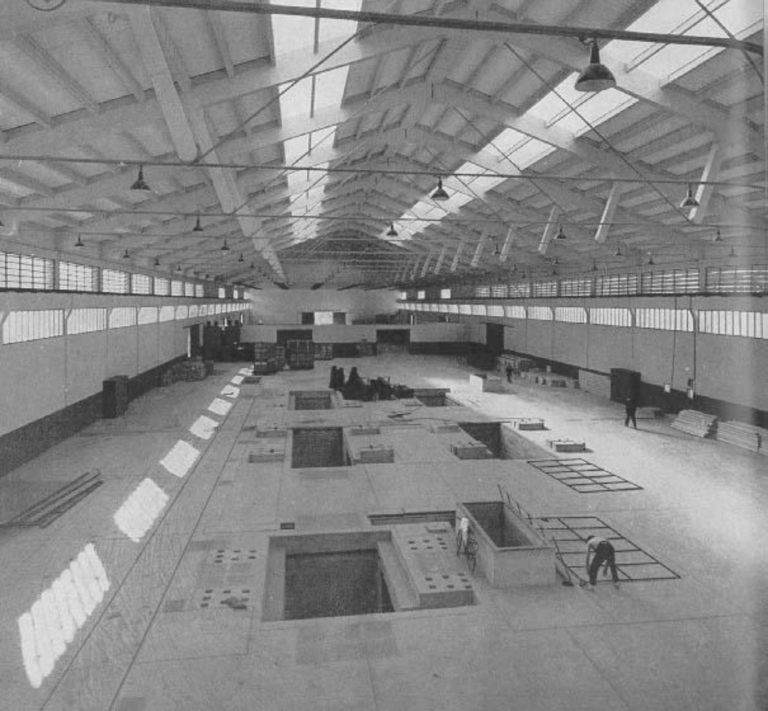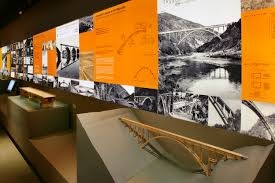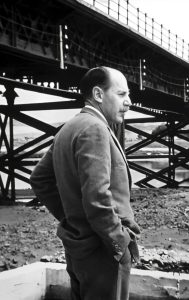
Carlos Fernández Casado
Logroño, 1905-Madrid, 1988
The son of an army general and the fourth of seven siblings, Carlos Fernández Casado lived in Logroño until his father was posted to Madrid. He was a brilliant student and completed his university degree in Civil Engineering at just 19. He moved to Paris to study the latest innovations in radio communications at the École Supérieure d’Électricité. After returning to Spain, he completed a degree in Telecommunications Engineering – also in record time. However, his professional and academic work remained connected to the field of civil engineering, and he become a leader in the discipline in Spain.
In the early years of his professional practice, he moved to Granada, where he completed a series of commissions as an engineer. There, he came into contact with a group of intellectuals, which included Federico García Lorca. Fernández Casado was an active member of Granada’s intellectual scene and a regular at the gatherings known as La Noche de Gallo, which Lorca organized at the city’s Athenaeum. His cultural interests also extended to close ties with the Instituto Escuela and the Institución Libre de Enseñanza, whose members included the family of his wife, Ritama Troyano de los Ríos, niece of Fernando de los Ríos.
His career was impacted by the Spanish Civil War, during which time he worked on strategic infrastructure for the Republican side, building concrete air-raid shelters, for example. After the war, he was penalized because of his Republican past; the sanction was not lifted until 1949. Likely due to his temporary inability to legally carry out projects as an engineer, in the early days of his professional career, his work was largely limited to theoretical production and teaching, which he continued even after he was able to resume his career as an engineer. He published numerous theoretical works on structures, foundations and bridge calculations. He was a teacher at the School of Civil Engineering in Madrid, where he became a full professor in the area of stone bridges and earned academic prestige through the publication of scientific articles and calculation manuals. In fact, his academic work is considered to have contributed to situating Spanish engineering on par with neighbouring European countries, and his teaching and writings had an enormous influence on students and future engineers, both in Spain and Ibero-America.
Once he was able to practice again professionally, he began collaborating with the construction company Huarte y Cía. on the Ciudad Universitaria de Madrid. There, he coincided with another eminent civil engineer, Eduardo Torroja Miret, who was in charge of the project, and with whom he had a tense relationship. His association with Félix Huarte, however, was long and fruitful, and as a result, he was able to access important engineering projects and put his theoretical knowledge into practice. His works served as practical examples of innovations being introduced for the first time in his country and as models for Spanish professionals. He pioneered the use of new construction techniques and materials such as prestressed concrete, promoting its introduction in Spain beginning in the 1950s.
The collaboration between Fernández Casado and Huarte led to some of the most notable achievements in post-war Spanish engineering, featuring technology that was advanced for its time. This includes his projects, based on prefabrication, for industrial buildings and bridges – warehouses for Ensidesa and INTA, the Chamartín stadium, the Madrid trolleybus station, etc. – which helped Huarte y Cía. become one of the most important construction companies with the largest technological capacity in the post-war period.
As a bridge builder, one of his first major projects was the Martín Gil Bridge in Zamora (1939-1942), where he applied innovative solutions to incorporate large spans and light weights. In the following decades, he participated in the construction of numerous emblematic bridges, including the Contreras Viaduct (1965). His ability to combine structural efficiency and aesthetics in his designs made him a landmark figure in 20th-century bridge engineering.
In 1963, he founded the company Carlos Fernández Casado SL Oficina de Proyectos, with two brilliant young engineers who would continue his work: his son, Leonardo Fernández Troyano, and Javier Manterola Armisén. Through this company, he developed major infrastructure projects in Spain and Latin America and was responsible for architectural projects such as the Torres Blancas building and the Banco de Bilbao tower in Madrid.
His legacy in the field of engineering extends beyond his buildings; his published texts and studies on structures have served as reference material for several generations of engineers. As a result, and because of his built work, he is one of the essential figures of civil engineering in mid 20th-century Spain. He received numerous awards throughout his career, including membership in the Spanish Royal Academy of Science and the Gold Medal of Merit in Labour.
In addition to the technical aspect of his career, he is remembered for his intellectual work: he was admitted to the Royal Academy of Fine Arts of San Fernando; his interests encompassed philosophy and aesthetics; and he was a scholar of Roman-era engineering and French Gothic cathedrals. His great intellectual curiosity and pursuit of universal knowledge led him, upon his return to Spain, to complement his education with a degree in History from the Faculty of Philosophy and Letters at the Complutense University of Madrid. He also began studying law and earned his degree at almost 70; after that, he even began university studies in psychology.
In 1983, in recognition of his career and work in designing and building bridges, the Ministry of Public Works christened one of the most important cable-stayed bridges in Spain as the “Engineer Carlos Fernández Casado Bridge”. Designed by Javier Manterola, it spans the Duero River at the Barrios de Luna reservoir in León.
Biography by Roger Subirà
Bibliography
- CRESPO, Antonio, Carlos Fernández Casado y la evolución del puente moderno en España, Fundación Juanelo Turriano, 2015.
- PUENTES, Javier, “Innovaciones estructurales en la obra de Carlos Fernández Casado”, in Revista de Ingeniería Civil 124, 2010.
- FERNÁNDEZ CASADO, Carlos, La arquitectura del ingeniero, Colegio de Ingenieros de Caminos, Madrid, 2006.
- AA VV, Carlos Fernández Casado: Ingeniero y maestro, Colegio de Ingenieros de Caminos, Canales y Puertos, Madrid, 1999.
- FERNÁNDEZ CASADO, Carlos, Historia del puente en España, Instituto Eduardo Torroja, 1980, Madrid.
- FERNÁNDEZ CASADO, Carlos, Historia del cálculo de estructuras, Instituto Eduardo Torroja de la Construcción y el Cemento, Madrid, 1957.
- FERNÁNDEZ CASADO, Carlos, Estructuras de edificios, Editorial Dossat, Madrid, 1955.
